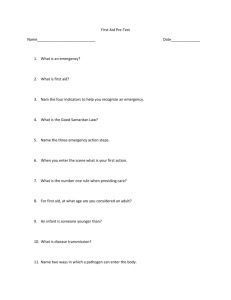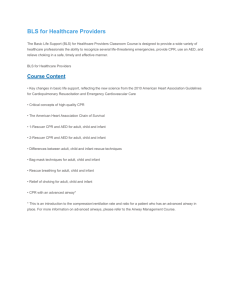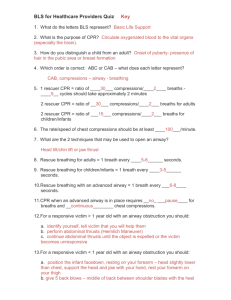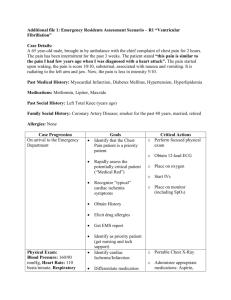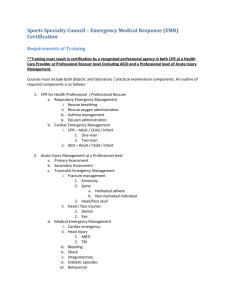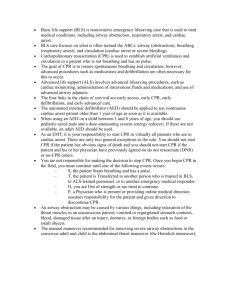Infant 1-and 2- Rescuer CPR Student Practice Check Sheet
advertisement
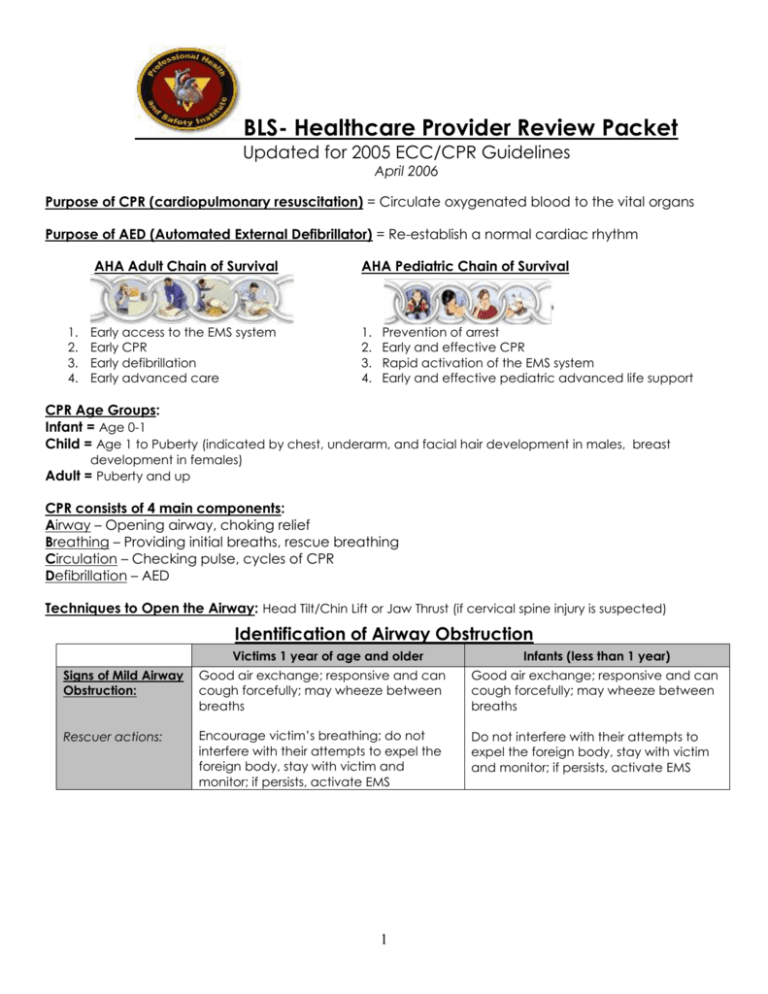
BLS- Healthcare Provider Review Packet Updated for 2005 ECC/CPR Guidelines April 2006 Purpose of CPR (cardiopulmonary resuscitation) = Circulate oxygenated blood to the vital organs Purpose of AED (Automated External Defibrillator) = Re-establish a normal cardiac rhythm AHA Adult Chain of Survival 1. 2. 3. 4. Early access to the EMS system Early CPR Early defibrillation Early advanced care AHA Pediatric Chain of Survival 1. 2. 3. 4. Prevention of arrest Early and effective CPR Rapid activation of the EMS system Early and effective pediatric advanced life support CPR Age Groups: Infant = Age 0-1 Child = Age 1 to Puberty (indicated by chest, underarm, and facial hair development in males, breast development in females) Adult = Puberty and up CPR consists of 4 main components: Airway – Opening airway, choking relief Breathing – Providing initial breaths, rescue breathing Circulation – Checking pulse, cycles of CPR Defibrillation – AED Techniques to Open the Airway: Head Tilt/Chin Lift or Jaw Thrust (if cervical spine injury is suspected) Identification of Airway Obstruction Victims 1 year of age and older Infants (less than 1 year) Signs of Mild Airway Obstruction: Good air exchange; responsive and can cough forcefully; may wheeze between breaths Good air exchange; responsive and can cough forcefully; may wheeze between breaths Rescuer actions: Encourage victim’s breathing; do not interfere with their attempts to expel the foreign body, stay with victim and monitor; if persists, activate EMS Do not interfere with their attempts to expel the foreign body, stay with victim and monitor; if persists, activate EMS 1 Signs of Severe Airway Obstruction: Poor or no air exchange; weak, ineffective cough or no cough; high-pitched noise while inhaling or no noise; increased respiratory difficulty; possible cyanosis (turning blue); unable to speak; clutching the neck with the thumb and fingers, making the universal choking sign; unable to move air Poor or no air exchange; weak, ineffective cough or no cough; highpitched noise while inhaling or no noise; increased respiratory difficulty; possible cyanosis (turning blue); unable to cry; unable to move air Rescuer actions: Ask “Are you choking?”. If victim nods and cannot talk, severe airway obstruction is present. Activate EMS and follow steps for care (see next page). If victim cannot make any sounds or breath, severe airway obstruction is present. Activate EMS when appropriate. follow steps for care (see next page). Relief of Severe Airway Obstruction Victims 1 year of age and older 1. Identify self, ask for permission to help (ask parent or guardian if child). 2. Perform abdominal thrusts *Use chest thrusts for obese or pregnant victims 3. Continue abdominal thrusts until the object is expelled or the victim becomes unresponsive. Responsive Victim w/ Severe Airway Obstruction Infant (<1 yr) 1. Position infant facedown, resting on forearm, head slightly lower than chest, supporting head and jaw with hand. Rest forearm on thigh. 2. 5 back slaps (middle of back btwn shoulder blades w/ heel of hand) 3. Carefully turn infant over as a unit, supporting head. Support infant on forearm. Rest forearm on thigh. 4. 5 chest thrusts (2 finger position just below the nipple line). 5. Repeat back slaps & chest thrusts until object is expelled or the infant becomes unresponsive. 2 Adult 1. Activate EMS Unresponsive Victim w/Severe Airway Obstruction 2. Open the airway, look for an object. If an object is visible, remove it. DO NOT perform a blind finger sweep. 3. Begin CPR** with one extra step: each time you open the airway, look for the object in the back of the throat. If you see an object, remove it. Child 1. Open the airway, look for an object. If an object is visible, remove it. DO NOT perform a blind finger sweep. 2. Begin CPR** with one extra step: each time you open the airway, look for the object in the back of the throat. If you see an object, remove it. 1. Place infant on firm, flat surface. 2. Open the airway, look for an object. If an object is visible, remove it. DO NOT perform a blind finger sweep. 3. Begin CPR** with one extra step: each time you open the airway, look for the object in the back of the throat. If you see an object, remove it. 4. After approximately 5 cycles (2 minutes) of CPR, activate EMS. 3. After approximately 5 cycles (2 minutes) of CPR, activate EMS. **Chest compressions give effective pressure in the chest and may be able to relieve the obstruction. Recovery Position A stable modified lateral position that maintains alignment of the back and spine while allowing the rescuer to observe and maintain access to the victim. Use the recovery position to manage unresponsive victims who have adequate breathing. When an unresponsive victim is breathing spontaneously, the tongue, mucus, or vomit may block the airway. By placing the victim on their side, fluid can drain from the mouth. You must still monitor the victim’s ABCs. **Not Recommended for small children, infants or trauma victims 3 Healthcare Provider Summary of Steps for Adults, Children, and Infants 4 Adult BLS Algorithm 5 Pediatric BLS Algorithm 6 Adult/Child 1-Rescuer CPR Student Practice Check Sheet You will practice and be evaluated on the following skills: 7 Adult 2-Rescuer CPR/AED Student Practice Check Sheet You will practice and be evaluated on the following skills: 8 Infant 1-and 2- Rescuer CPR Student Practice Check Sheet You will practice and be evaluated on the following skills: 9 Importance of Early CPR and AED 10 Life Threatening Emergencies: Sudden Cardiac Arrest, Heart Attack, Stroke Etiology Warning Signs Risk Factors Can happen at any age, both genders, any race Sudden Cardiac Arrest (SCA) Circulation ceases, vital organs do not receive oxygen due to sudden onset of ventricular fibrillation (VF) Sudden collapse with little to no warning signs. No response to gentle shaking. Victim will not be breathing and will have no pulse. Some conditions such as Marfan’s Syndrome and Hypertrophic Cardiomyopathy (HCM) increase the risk of SCA. Blunt blows to the chest (Commotio Cordis) may also induce SCA. Heart Attack (Myocardial Infarction) Severe narrowing of coronary artery by cholesterol plaque Cracking or erosion of plaque with formation of a blood clot, leading to complete blockage of artery. OR Blood vessel spasm (i.e. due to cocaine) Area of the heart is deprived of blood flow and oxygen for a prolonged period (< 20-30 min) and heart muscle begins to die. Stroke Blood clot forms blocking blood in an artery from bringing blood to part of the brain. Result of atherosclerosis. OR Hemorrhage (bleeding) of an artery in the brain caused by brain injury or aneurysm. Chest discomfort; shortness of breath; nausea; sweating; lightheadedness w/chest discomfort; fainting; anxiety/feelings of doom Atypical Signs: elderly, diabetics, women most likely to present unusual or vague, nonspecific complaints (i.e. weakness) Shortness of breath, syncope or lightheadedness may be only signs in diabetics. Sudden weakness/numbness on one side of body; loss, slurred or incoherent speech; unexplained dizziness, unsteadiness or sudden falls; dimness or loss of vision in one eye; loss of consciousness; severe or intense headache Unmodifiable: Heredity; male gender; increasing age Modifiable: Untreated hypertension; smoking; elevated blood cholesterol; physical inactivity; contributing factors = diabetes, obesity, stress Unmodifiable: Heredity; increasing age; race (Black Americans); diabetes; prior stroke; female gender Modifiable: Hypertension; smoking; heart disease; high red blood cell count; transient ischemic attacks (TIAs); physical inactivity 11 Appropriate Actions Recognize warning signs; activate EMS and begin CPR. If an AED is available, use it. Note: Victims in SCA will often have agonal gasps. They are ineffective and will not maintain oxygenation or ventilation. Recognize warning signs; activate EMS immediately; stay with victim; have victim rest quietly in comfortable position; monitor ABC’s & be prepared to start CPR. Get an AED if available. Recognize warning signs; activate EMS immediately; stay with victim; try to establish exact time of onset of symptoms; have victim rest quietly in comfortable position; monitor ABCs & be prepared to start CPR. Get an AED if available. Research Notes Defibrillation is the only definitive treatment for VF SCA. * 90% effective if first shock is delivered w/in 4 minutes of cardiac arrest w/ at least 1min of CPR. * 70% effective if first shock is delivered w/in 4 minutes of cardiac arrest w/ no CPR. * Effectiveness decreases by 10% each minute after. Ischemic heart muscle may develop abnormal electrical rhythms including VF. Out-ofhospital cardiac arrest from heart attack develops w/in the first 4 hrs of onset of symptoms. Framingham Study FollowUp: 1/3 of first MI in men and ½ in women were clinically unrecognized. ½ of these were truly silent, other ½ had atypical presentation. Cerebral thrombosis (clots) and embolism most common types of strokes (70-80%). If given within three hours of the start of symptoms, a clot-busting drug can reduce long-term disability for the most common type of stroke. 12
